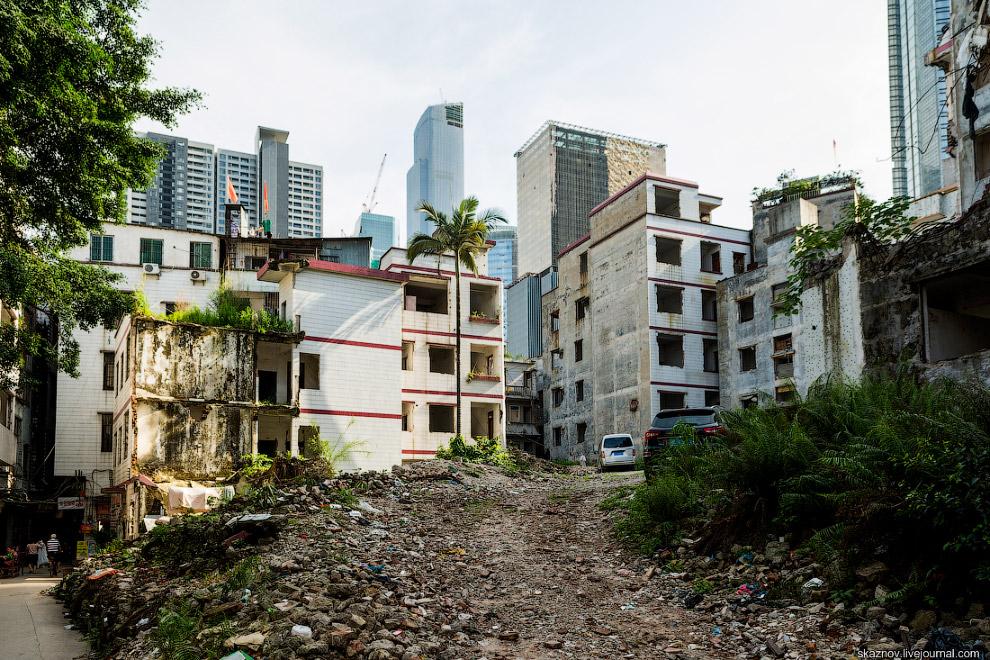
Megacities and slums
The global dominance of European and American metropolitan areas is an almost completely forgotten past. For example, according to the US Census Bureau's population estimate, in the twelve months to July 2018, only a few southern cities grew in the US, while populations declined in the old metropolitan areas of New York, Chicago, and Los Angeles.
According to the Global Cities Institute, African agglomerations will become the largest cities in 2100. These are already great metropolitan areas, known not so much as magnificent spaces full of great architecture and offering a high quality of life, but as vast oceans of slums that have long overtaken old slum cities such as mexico city (1)
1. Waves of the slums of a big city in Mexico City
capital of Nigeria, Lagos (2) is one of the fastest. In fact, no one knows the exact size of its population. The UN estimated that 2011 million people lived there in 11,2, but a year later The New York Times reported that it was about at least 21 million. According to the Global Cities Institute, the city's population will reach the end of this century. 88,3 millionmaking it the largest metropolitan area in the world.
Capital of the Democratic Republic of the Congo Kinshasa, was a group of fishing villages several decades ago. She has now surpassed Parisand GCI predicts that by 2100 it will be second in the world after Lagos, with 83,5 million inhabitants. Other estimates suggest that by 2025, 60% of the 17 million people living there will be under the age of eighteen, which is expected to act like yeast on steroids.
According to these forecasts, Tanzanian should become the third city in the world by the end of the century. Dar es Salaam z 73,7 million inhabitants. Demographers predict that East Africa in eighty years will be filled with multimillion-dollar megacities, and the cities that occupy the top ten megacities in the current decade, mainly Asian, will be replaced by little-known places today, such as Blantyre City, Lilongwe i Lusaka.
According to GCI forecasts, by 2100 only Indian metropolitan areas such as Bombaj (Mumbai) – 67,2 millionи Delhi i Calculateboth after over 50 million citizens.
The development of these gig cities is associated with many unacceptable consequences. Twenty-two of the thirty most polluted agglomerations of the world are located. According to a report by Greenpeace and AirVisual, of the ten cities in the world with the highest levels of air pollution, as many as seven are located in India.
Chinese cities used to lead this infamous category, but they have seen a marked improvement. Leading in the ranking gurugram, a suburb of the Indian capital, New Delhi, the most polluted city on Earth. In 2018, the average air quality score was nearly three times higher than what the U.S. Environmental Protection Agency considers a direct health hazard.
The Chinese dream of metropolitan hippos
In 1950, when the relevant data were first collected, twenty of the thirty largest metropolitan areas were located, let's say, in the countries of the first world. The largest city in the world at the time was New York City, with a population of 12,3 million. Second on the list Tokyo, there were 11,3 million. There were no more cities with a population of more than 10 million people (or, to be more precise, urban agglomerations, since we do not take into account the administrative boundaries of cities in this case).
There are currently twenty-eight of them! It is estimated that by 2030, only four megacities from countries that are considered developed today will remain in the list of the thirty largest agglomerations of the world. They should be Tokyo i Osaka Oraz NY i Los Angeles. However, only Tokyo (3) is expected to remain in the top ten. Moreover, probably until the end of the next decade, the capital of Japan will also retain the title of the largest metropolis in the world, although the population there is no longer growing (according to various sources, it ranges from 38 to even 40 million).
The Chinese are mixed in the rankings of the largest cities. Overwhelmed by a kind of megalomania, they make plans and actually create gigantic administrative organisms that formally become or can become the world's largest metropolitan areas.
Already a few years ago, we read about the concept of creating a giant city in the Middle Kingdom larger than Uruguay and more populous than Germany, which now has about 80 million people. Such a creation will arise if the Chinese authorities implement their plan to enlarge the capital of Beijing with large territories of the province of Hebei and join the city of Tianjin to this structure. According to official plans, the creation of such a huge urban creature should alleviate smog-choking and smog-ridden Beijing and housing for the still arriving population from the provinces.
Jing-Jin-Ji, because that's the name of this project to reduce the typical problems of a big city by creating an even bigger city, it should have 216 thousand. km². The estimated number of inhabitants should be 100 mln, making it not only the largest metropolitan area, but also an organism more densely populated than most countries in the world - more than the hypothetical Lagos in 2100.
Perhaps the test of this concept is the "city". Chongqing , also known as Chongqing, has recently topped many lists of the world's largest metropolitan areas, surpassing Shanghai, Beijing, Lagos, Mumbai and also Tokyo. For Chongqing, the number of inhabitants of the "real city" indicated in the statistics is almost 31 million inhabitants and almost four times higher than in the "agglomeration".
The large area (4) indicates that this is a densely populated commune, artificially turned into a city. Administratively, it is one of four Chinese municipalities under direct central government (the other three being Beijing, Shanghai, and Tianjin) and the only such municipality in the Celestial Empire located far from the coast. The hypothesis that the Chinese authorities are testing how these organisms function before they themselves create an urban behemoth in the north is probably not unfounded.
4. Map of Chongqing against the backdrop of all of China.
It is worth remembering that there is some confusion in the rankings and data on the size of cities. Their authors sometimes take into account only the size of the cities themselves, which - due to the fact that administrative cities were often artificially designated - is most often considered a bad indicator. Agglomeration data is usually used more often, but in these cases the boundaries often remain fluid and there are different definitions of the so-called megalopolises.
In addition, there is the problem of the accumulation of large urban centers, the so-called. megalopoliseswith many centers without the dominance of one "city". I think it's something like this Guangzhou (Canton), which, according to the German site citypopulation.de, must have at least 48,6 million inhabitants – after adding all major cities in the vicinity, incl. Hong Kong, Macau and Shenzhen.
Not size, not quantity, but quality
The Chinese idea of solving the problems of megacities by building even larger megacities is recognized only in China itself. In the developed Western countries, it is currently moving in a completely different direction. Instead of, for example, allocating more land for urban development and reducing the area of arable land or forests, more and more often it is smart urban solutions, quality of life and ecology.aiming for zero inconvenience to the environment and the people living in it.
There are even those who want to go back in time, return the human dimension to cities and ... The authorities of Hamburg plan to clear 40% of the city from car traffic over the next twenty years.
Prince Charles Foundation in turn, he remakes entire cities like medieval ones - with squares, narrow streets and all services five minutes from home. Actions also return to sources She is Gela, a Danish architect who does not create new large projects, but returns the "human scale" to cities. The architect emphasizes that six of the ten most rated cities in the world in terms of quality of life have already passed the “humanization” procedure developed by his team. Copenhagen, Gel's hometown, ranks first in this group - it was here that in the 60s he began to study the behavior of people in the city.
Thus, the future of urban development in the world looks something like this: on the one hand, ever cleaner, more humane and environmentally friendly cities in the north, and gigantic, compacted to unimaginable boundaries, polluted by everything that a person can produce, slums. abyss in the south.
In order to improve the quality of life and functioning of residents in each district, smart citiesusing advanced technologies such as smart building. According to this assumption, the inhabitants should live better and more comfortably, and at the same time, the costs of functioning of the entire urban organism should be as low as possible.
In The 2018 Smart Cities Index, published in 2017, i.e. the ranking of the smartest cities in the world prepared by EasyPark Group is dominated by European "addresses", with Copenhagen, Stockholm i Zurich at the forefront.
However, Asian smart cities, which are growing the fastest, are also gaining momentum. By continent, the list of the 57 smartest cities includes: 18 agglomerations from Europe, 14 from Asia, 5 from North America, 5 from South America, XNUMX from Australia and one from Africa.
An important concept in the new urban development is the quality of life, which means many different aspects and, probably, everyone understands it a little differently. For some it is the low cost of living, affordable housing and health care, for others it is the low levels of pollution, traffic and crime. Numbeo, a global user-driven database, provides quality of life data for cities around the world. Based on them, a global ranking was created.
Australia is especially good there. Cities are in the first place - Canberra (5), fourth (Adelaide) and seventh (Brisbane). The USA has four representatives in the top ten and it is not the largest metropolis at all. From Europe, the Dutch came in second. Eindhovenand Zurich in fifth. On our continent, quality of life is definitely linked to wealth, if only because of real estate prices.
Of course, both the quality of life and the ecology can change dramatically in the rich cities of the North, if the southern slums-pillars, where life becomes unbearable, want to come to them.
But that's a topic for another story.
